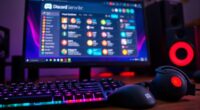Digital burnout silently impacts you by causing screen fatigue, mental exhaustion, and physical discomfort like eyestrain and headaches. Constant exposure to notifications and multitasking hampers your focus, increases stress, and disrupts sleep. Ignoring these signs worsens your health over time. To protect yourself, it’s vital to take regular breaks, limit digital use, and prioritize self-care. If you want to discover effective ways to regain balance, keep exploring the strategies that can help.
Key Takeaways
- Constant connectivity leads to mental exhaustion, irritability, and difficulty disconnecting, contributing to digital burnout.
- Prolonged screen time causes physical issues like eye strain, headaches, and disrupted sleep patterns.
- Multitasking and notifications impair focus, increasing stress and reducing overall productivity.
- Implementing regular breaks and limiting device use can help alleviate digital fatigue and improve well-being.
- Balancing digital engagement with self-care practices is essential to prevent long-term health consequences.

In today’s hyper-connected world, digital burnout has become an all-too-common experience for many. You might find yourself constantly glued to your devices, feeling overwhelmed by the endless stream of notifications, emails, and social media updates. This relentless exposure leads to tech overload, where your brain struggles to process the constant influx of information. Over time, this can cause screen fatigue, leaving you mentally drained and physically exhausted. You may notice your eyes aching, headaches intensifying, or a sense of irritability creeping in after hours of staring at screens. The more you stay connected without breaks, the more your mind becomes overwhelmed, making it hard to focus or feel motivated.
Digital overload leads to screen fatigue, mental exhaustion, and irritability—taking breaks is essential for your well-being.
Tech overload isn’t just about the quantity of screen time—it’s also about how it affects your mental state. When you’re constantly switching between apps, messages, and notifications, your brain is working overtime. This constant multitasking can impair your ability to concentrate, reduce your productivity, and increase stress levels. You might find yourself checking your phone impulsively, feeling anxious if you’re not immediately responsive. The pressure to stay updated and available creates a cycle that’s hard to break, leaving you feeling perpetually behind or anxious about missing out.
Screen fatigue adds another layer to this issue. Prolonged exposure to screens causes eye strain, dry eyes, blurred vision, and headaches. When your eyes are strained, your body signals discomfort, but many ignore these signs, pushing through to finish tasks or scroll just a little longer. The blue light emitted from screens interferes with your sleep cycle, making it harder to rest properly. Poor sleep then worsens your mental state, increasing feelings of exhaustion and reducing your ability to recover from daily stressors. This cycle feeds into digital burnout, making it harder to disconnect and find balance.
To combat tech overload and screen fatigue, it’s vital to set boundaries. Take regular breaks—use techniques like the 20-20-20 rule: every 20 minutes, look at something 20 feet away for at least 20 seconds. Limit your social media and email checking to designated times rather than constant scrolling. Invest in ergonomic setups to reduce eye strain and get plenty of natural light to help reset your circadian rhythms. Consider using high-quality projectors to create a dedicated entertainment space that can help you enjoy screen time in a more controlled environment. Remember, disconnecting isn’t a sign of weakness; it’s a necessary act of self-care. Recognizing these signs early can help you regain control, reduce digital burnout, and protect your mental and physical health in this always-on world.
Frequently Asked Questions
How Can I Tell if I Have Digital Burnout?
If you’re wondering how to tell if you have digital burnout, look for signs like increased screen dependence and tech exhaustion. You might feel overwhelmed, irritable, or tired even after resting. You could also notice a decline in focus or motivation, along with physical symptoms like headaches or eye strain. These signals indicate your body and mind are struggling with constant digital engagement, so taking breaks and setting boundaries can help restore balance.
What Are Quick Tips to Reduce Screen Time Daily?
Did you know the average person spends over 7 hours a day on screens? To cut down, create tech-free zones in your home, like the bedroom or dining area, and set specific times to check your devices. Practice mindful device use by turning off notifications and focusing on one task at a time. These quick tips help reduce screen time daily and promote healthier digital habits.
Are There Specific Apps to Help Manage Digital Fatigue?
If you’re looking to manage digital fatigue, several apps can help. App blockers like Freedom or StayFocusd prevent you from wasting time on distracting sites, while usage trackers such as Screen Time or Moment monitor your screen time habits. These tools give you insight into your digital habits, encouraging healthier routines. Using them actively helps you set boundaries, reduce stress, and regain control over your online life.
How Does Digital Burnout Affect Mental Health Long-Term?
Imagine your mind as a delicate garden, easily overrun by weeds. Digital burnout quietly chips away at your mental health long-term, intensifying the mental health stigma and amplifying social media’s impact. You might feel overwhelmed, anxious, or isolated, but recognizing this helps you reclaim control. Left unchecked, it can lead to deeper issues—so prioritize digital boundaries to nurture your mental well-being and keep your mental health garden flourishing.
Can Digital Detox Retreats Improve Recovery From Burnout?
A digital detox retreat can definitely help you recover from burnout. By practicing mindful tech and unplugging strategies, you give yourself time to reset mentally and physically. During these retreats, you disconnect from constant notifications and social media, allowing space for reflection and relaxation. This intentional break helps restore your focus, reduce stress, and rebuild healthy tech habits, making it easier to manage digital overload in the long run.
Conclusion
If you keep burning the candle at both ends, you’ll find yourself in a dark room with no light to guide you. Digital burnout silently drains your energy, blurs your boundaries, and leaves you feeling empty. To stay balanced, you need to step back, unplug, and recharge. Remember, technology should serve you—not drain you. Protect your glow by setting boundaries, so you don’t burn out before your true self can shine again.










